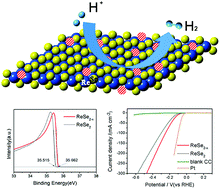Electrochemical activity of 1T′ structured rhenium selenide nanosheets via electronic structural modulation from selenium-vacancy generation†
Abstract
Recently, rhenium selenide, a transition metal dichalcogenide, has been electrocatalytically synthesized for use in the hydrogen evolution reaction (HER). However, sample fabrication is still far from satisfactory owing to the plain electrochemical performance and it is still a challenge to synthesize ReSe2 with excellent controllable properties to meet the high level demands of substitution for noble metals. Herein, we report an effective route to fabricate triclinic rhenium selenide (ReSe2−x) nanosheets with enhanced HER performance via electronic structure modulation from abundant Se vacancies, tuned via a hot-injection colloidal process. High resolution transmission electron microscopy (HRTEM), Raman, photoluminescence (PL) and electron paramagnetic resonance (EPR) studies in addition to energy dispersive X-ray spectroscopy (EDX) and inductively coupled plasma-atomic emission spectrometry (ICP-AES) investigations demonstrated that the ReSe2−x nanosheets were composed of 1–3 layers with bountiful Se vacancies. High-resolution synchrotron radiation photoemission spectroscopy (HR-SRPES), ultraviolet photoelectron spectroscopy (UPS), electrochemical tests and theoretical calculations indicate that the controllable generation of the ReSe2−x nanosheets with Se vacancies could notably lead to enlarged pore volumes with densely active catalytic sites based on the electronic structure modification of the nanostructured electrode, and could thus be favorable for the improvement of the HER properties. Specifically, in acidic media, a current density of 10 mA cm−2 can be achieved at an overpotential of 102 mV, and 100 mA cm−2 at 249 mV. Furthermore, the high current density of ∼100 mA cm−2 is preserved at a constant overpotential of 250 mV, even after 12 h of electrolysis.



 Please wait while we load your content...
Please wait while we load your content...